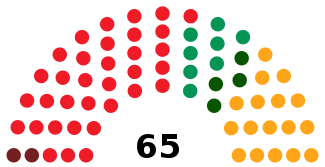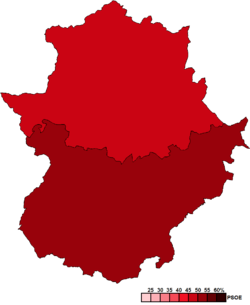Extremaduran regional election, 1987
| |||||||||||||||||||||||||||||||||||||||||||||||||||||||||||||||||||||||||||||||||||||||||
All 65 seats in the Assembly of Extremadura 33 seats needed for a majority | |||||||||||||||||||||||||||||||||||||||||||||||||||||||||||||||||||||||||||||||||||||||||
| Opinion polls | |||||||||||||||||||||||||||||||||||||||||||||||||||||||||||||||||||||||||||||||||||||||||
| Registered |
808,654 | ||||||||||||||||||||||||||||||||||||||||||||||||||||||||||||||||||||||||||||||||||||||||
| Turnout |
601,615 (74.4%) | ||||||||||||||||||||||||||||||||||||||||||||||||||||||||||||||||||||||||||||||||||||||||
| |||||||||||||||||||||||||||||||||||||||||||||||||||||||||||||||||||||||||||||||||||||||||
|
Constituency results map for the Assembly of Extremadura | |||||||||||||||||||||||||||||||||||||||||||||||||||||||||||||||||||||||||||||||||||||||||
| |||||||||||||||||||||||||||||||||||||||||||||||||||||||||||||||||||||||||||||||||||||||||
The 1987 Extremaduran regional election was held on Wednesday, 10 June 1987, to elect the 2nd Assembly of the Autonomous Community of Extremadura. All 65 seats in the Assembly were up for election. The election was held simultaneously with regional elections in 12 other autonomous communities and local elections all throughout Spain, as well as the 1987 European Parliament election.
The Spanish Socialist Workers' Party (PSOE) won the election with a new absolute majority of seats, albeit losing 1 seat from its 1983 result. The People's Alliance (AP), which had undergone an internal crisis after the breakup of the People's Coalition in 1986, lost support and fell from the coalition's 30% of the share to 24%, losing 3 seats as a result.
The main election winner was the centrist Democratic and Social Centre (CDS), a party led by the former Spanish Prime Minister Adolfo Suarez, which entered the Assembly for the first with 8 seats and 12% of the vote, becoming the only party within the Assembly that made gains, as all others (including regionalist United Extremadura (EU)) lost votes. United Left, an electoral coalition comprising the Communist Party of Spain and other left-wing parties, also lost 2 seats.
Electoral system
The 65 members of the Assembly of Extremadura were elected using the D'Hondt method and a closed list proportional representation, with a threshold of 5 per 100 of valid votes—which included blank ballots—being applied in each constituency. Parties not reaching the threshold were not taken into consideration for seat distribution. Alternatively, parties failing to reach the threshold in one of the constituencies would also be entitled to enter the seat distribution as long as they ran candidates in both districts and reached 5 per 100 regionally. Seats were allocated to constituencies, corresponding to the provinces of Badajoz and Cáceres. Each constituency was entitled to an initial minimum of 20 seats, with the remaining 25 allocated among the constituencies in proportion to their populations.[1][2] Voting was on the basis of universal suffrage, with all nationals over eighteen, registered in Extremadura and in full enjoyment of all political rights entitled to vote.
The electoral law provided that parties, federations, coalitions and groupings of electors were allowed to present lists of candidates. However, groupings of electors were required to secure at least the signature of 2 per 100 of the electors entered in electoral register of the constituency for which they were seeking election. Electors were barred from signing for more than one list of candidates. Concurrently, parties and federations intending to enter in coalition to take part jointly at an election were required to inform the relevant Electoral Commission within ten days from the election call.[1][3][4]
Elections were fixed to be held within 30 to 60 days from the legislature's expiry date, which would take place four years after the previous election. Additionally, the chamber was to be automatically dissolved and a snap election called if an investiture process failed to elect a regional President within a two-month period from the first ballot, with elected deputies merely serving out what remained of their four-year terms.[2][3]
Opinion polls
Individual poll results are listed in the table below in reverse chronological order, showing the most recent first, and using the date the survey's fieldwork was done, as opposed to the date of publication. If that date is unknown, the date of publication is given instead. The highest percentage figure in each polling survey is displayed with its background shaded in the leading party's colour. In the instance of a tie, the figures with the highest percentages are shaded. in the case of seat projections, they are displayed in bold and in a different font. The lead column on the right shows the percentage-point difference between the two parties with the highest figures. 33 seats were required for an absolute majority in the Assembly of Extremadura.
| Polling firm/Commissioner | Fieldwork date | Sample size | Turnout | |
|
|
|
|
Lead |
|---|---|---|---|---|---|---|---|---|---|
| 1987 regional election | 10 Jun 1987 | N/A | 74.4 | 49.2 34 |
24.2 17 |
5.8 4 |
5.4 2 |
12.4 8 |
25.0 |
| Demoscopia/El País[p 1] | 22–26 May 1987 | ? | ? | 49.1 35 |
27.5 17 |
7.2 6 |
3.4 1 |
9.7 6 |
21.6 |
| Sofemasa/AP[p 2][p 3] | 17 Apr 1987 | ? | ? | 43.5 | 24.1 | – | 4.8 | 14.5 | 19.4 |
| 1986 general election | 22 Jun 1986 | N/A | 73.6 | 55.9 39 |
26.7 19 |
2.7 1 |
3.9 1 |
8.0 5 |
29.2 |
| 1983 regional election | 8 May 1983 | N/A | 71.9 | 53.0 36 |
30.1 20 |
8.5 6 |
6.5 4 |
0.8 0 |
22.9 |
Results
Overall
 | ||||||
| Parties and coalitions | Popular vote | Seats | ||||
|---|---|---|---|---|---|---|
| Votes | % | ±pp | Won | +/− | ||
| Spanish Socialist Workers' Party (PSOE) | 292,935 | 49.18 | –3.84 | 34 | –1 | |
| People's Alliance (AP)1 | 144,117 | 24.19 | –5.91 | 17 | –3 | |
| Democratic and Social Centre (CDS) | 73,572 | 12.35 | +11.56 | 8 | +8 | |
| United Extremadura (EU) | 34,606 | 5.81 | –2.67 | 4 | –2 | |
| United Left (IU)2 | 32,240 | 5.41 | –1.07 | 2 | –2 | |
| Parties with less than 1.0% of the vote | 13,425 | 2.25 | — | 0 | ±0 | |
|---|---|---|---|---|---|---|
| Workers' Party of Spain–Communist Unity (PTE–UC) | 5,317 | 0.89 | New | 0 | ±0 | |
| People's Democratic Party (PDP) | 5,203 | 0.87 | New | 0 | ±0 | |
| Liberal Party (PL) | 2,286 | 0.38 | New | 0 | ±0 | |
| Humanist Platform (PH) | 619 | 0.10 | New | 0 | ±0 | |
| Blank ballots | 4,785 | 0.80 | +0.33 | ||||||
| Total | 595,680 | 100.00 | 65 | ±0 | |||||
| Valid votes | 595,680 | 99.01 | –0.08 | ||||||
| Invalid votes | 5,935 | 0.99 | +0.08 | ||||||
| Votes cast / turnout | 601,615 | 74.40 | +2.50 | ||||||
| Abstentions | 207,039 | 25.60 | –2.50 | ||||||
| Registered voters | 808,654 | ||||||||
| Source(s): Argos Information Portal, historiaelectoral.com | |||||||||
| |||||||||
Distribution by constituency
| Constituency | PSOE | AP | CDS | EU | IU | |||||
|---|---|---|---|---|---|---|---|---|---|---|
| % | S | % | S | % | S | % | S | % | S | |
| Badajoz | 51.9 | 19 | 23.8 | 9 | 13.2 | 5 | 1.6 | − | 7.0 | 2 |
| Cáceres | 45.1 | 15 | 24.9 | 8 | 11.1 | 3 | 12.2 | 4 | 3.0 | − |
| Total | 49.2 | 34 | 24.2 | 17 | 12.4 | 8 | 5.8 | 4 | 5.4 | 2 |
Opinion poll sources
- ↑ "Los socialistas mantienen la hegemonía" (PDF). El País (in Spanish). 4 June 1987.
- ↑ "Una encuesta de AP pronostica un fuerte descenso del PSOE en las municipales". ABC (in Spanish). 17 April 1987.
- ↑ "Notable descenso del PSOE en los próximos comicios, según una encuesta encargada por AP". ABC Sevilla (in Spanish). 17 April 1987.
References
- 1 2 Law of Elections to the Assembly of Extremadura of 1987, Law No. 2 of March 16, 1987 Official Journal of Extremadura (in Spanish). Retrieved on 17 March 2017.
- 1 2 Statute of Autonomy of Extremadura of 1983, Organic Law No. 1 of February 25, 1983 Official State Gazette (in Spanish). Retrieved on 17 March 2017.
- 1 2 General Electoral System Organic Law of 1985, Organic Law No. 5 of June 19, 1985 Official State Gazette (in Spanish). Retrieved on 28 December 2016.
- ↑ "Representation of the people Institutional Act". juntaelectoralcentral.es. Central Electoral Commission. Retrieved 16 June 2017.
.jpg)

